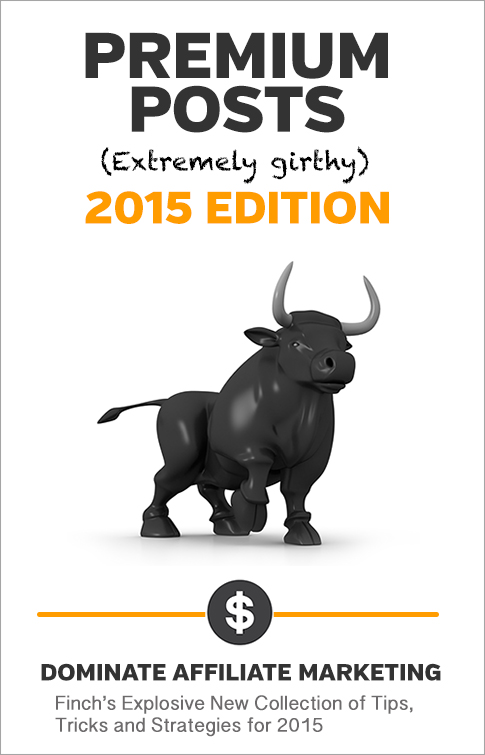Here’s an interesting question I received from a reader:
Say you are starting affiliate marketing today with a $5,000 budget — what’s the best way to turn this type of budget in to a long-term affiliate business? And how long would it take?
I see this dilemma often.
“I have XXXX in the bank. My skills are A, B and C. Please tell me how to turn the above in to an affiliate machine that prints money.”
The obvious answer is that there is no obvious answer. But I don’t think many people are satisfied with that, so let’s try and piece together some rough strategies you could follow.
$5,000 is a pretty decent budget.
First of all, some key assumptions:
#1. The $5,000 has to be completely disposable.
If you are intending to draw down the $5,000 to cover living expenses, or to rely on as savings, then it isn’t a genuine budget. It’s a package with emotional strings attached.
It’s better to start with a $1,000 budget that you can afford to lose, rather than $5,000 that you’ve mentally invested elsewhere.
#2. Your living expenses are paid for until the affiliate business has succeeded.
$5,000 is a nice amount for testing campaigns, but it’s not enough cash to run a successful long-term affiliate business.
We’d have to assume that your living expenses are covered by a secondary income and that you won’t be drawing down any profits until you have a successful business in place.
Where to Start?
Let’s run through some of the popular affiliate verticals, as well as some other well known money-making strategies.
The question here being, “Which strategies are suitable for newbie affiliates with $5,000 to burn?”
‘Go Mobile’?
When newbies ask for guidance, what’s the recurring piece of advice you hear?
“It’s 2015, buddy. Time to go mobile…”
Mobile offers are all the rage these days.
That’s nice, but it’s pretty bloody useless as career advice.
When was the last time you heard an affiliate say, “There’s money in Desktop”?
The thing is, there is money in traditional web-based ‘desktop’ offers — but nobody phrases it like that because to do so would be to completely miss the point.
‘Going mobile’ is a term used by many affiliates seeking the next big trend, but until you can actually pinpoint what market you plan to serve, it’s the equivalent of a Walmart Wannabe deciding to ‘go retail’.
There are four main models we can attack in mobile marketing:
- App installs
- Pin submits
- Mobile lead gen
- Pay-per-call
For somebody with a $5,000 budget, this is how I would rank them:
1. App installs — These have low payouts (cheaper testing), with simple conversion flows, and they are available in many different markets including some that are unsaturated. You can test these offers cost-effectively. A good choice.
2. Pay-per-call — Second best bet. As I explained in Premium Posts 2015, it’s difficult to make a huge loss promoting pay-per-call on AdWords and Bing. The metrics are simple. You can cut your losses fast. There’s much more signal in the data with these offers.
3. Mobile lead gen — Mobile lead gen offers pose the same challenge as those on the web, although quality issues can be difficult to predict. This isn’t a bad starting point, but it’s probably not the best while advertisers are still coming to terms with monetising mobile users.
4. Pin submits — By far the toughest nut to crack on a $5,000 budget. Pin submits generally have higher payouts and higher testing costs. Finding a winning formula can be obtuse, to say the very least. You are tied to mobile carriers, and they are notoriously up-and-down. I recommend you avoid them on this budget.
Once you decide to ‘go mobile’ and focus your efforts on one of these four models, there’s still more work to do.
Ideally you should be narrowing your search to a single market or region (preferably one that isn’t saturated), and a single vertical that operates under your chosen model.
For example, you could choose to focus on:
- App installs > Utility apps > South East Asia.
- App installs > Gaming apps > DACH
- Mobile lead gen > Dating offers > AU/NZ.
In short, one does not simply decide to ‘go mobile’ on a $5,000 budget and live to refresh his stats happily.
You need a strategy that cuts much deeper than simply: “Hey, you know what? I’m sick of desktops. All these bastards using their mobiles? I shall convert them starting Monday.”
CONVERT THEM TO WHAT?
Facebook
To succeed on Facebook in 2015, most affiliates rely on three structural advantages:
- Excellent cloaking.
- Access to accounts (infrastructure).
- Cashflow to hit a winner hard while it lasts.
$5,000 doesn’t buy you even one of the above.
It’s not a traffic source I can recommend to newbies.
Adult Dating
Networks like TrafficJunky, ExoClick and TrafficForce provide easy access to the big money adult dating vertical.
It’s a popular starting point for newbie affiliates, probably because so much of the vertical is, err, graspable at first sight.
In truth, adult dating traffic has become so fragmented that you’d do well to blow through $5,000 without learning a lot along the way.
That’s unless you were to do something stupid — like place top bids on Xhamster in the United States.
The problem most affiliates have isn’t losing money, it’s not making money. There’s a huge plateau of adult affiliates stuck perennially at break even.
If you want to grow your $5,000, you’ll have to focus on out-working the competition by scalping pockets of profit that are ignored by larger advertisers.
Or you can tackle Tier 3 countries where low volume still trades for a decent ROI.
Avoid advertising to Tier 1 countries with a $5,000 budget.
That’s not to say you can’t strike success, but the ROI will be much lower than if you execute the same strategy on a less saturated market.
PPV
Pay-per-view networks (PPV) exploded back in 2009 and 2010.
They have declined in popularity since then.
HOW IT WORKS: PPV networks serve ads to users who have installed third party software (usually a toolbar) on their computers. The advertiser can target users based on their current browsing activity. For example if you were browsing Pets.com, I could target you with a pop-up saying, “HI PETS LOVER, PLEASE LIKE & SHARE MY DOG.” In reality… I probably wouldn’t do this.
Even TrafficVance, the crème de la crème of PPV sources, just recently ditched its long standing requirement that new members must have a referral in to the network. It’s a pretty open playing field these days.
PPV networks may offer a shrinking audience, but that audience is large enough to make good money from.
Some of my highest ROI campaigns in 2014 came from combining PPV traffic with pay-per-call offers, often under dubious circumstances (See Premium Posts 2015).
The precise nature of the targeting means you can easily find small volume campaigns with high ROI that are perfect for growing capital and cutting your teeth in the business.
On a budget of $5,000, PPV is a good choice.
Plentyoffish (POF)
Another traffic source that was massively popular 2-3 years ago.
It’s unlikely you’ll stumble in to the same $1000/day campaigns that were bread and butter back then, but POF remains a good choice for high ROI, low risk profiteering.
The amount of targeting available means that you are unlikely to miss the mark so badly that you’d blow through a $5,000 budget.
I just read a success story on STM of a guy who only started on POF in October 2014, with no formal experience in ‘web stuff’.
He’s now making a comfortable $500/day profit, whilst building out a team of employees to help him scale.
His budget getting started? $4,000.
Whilst these success stories are reasonably common in affiliate marketing, that does not mean that ‘anybody can do it’.
When you read through the actual follow along, it’s clear that his success = application, hard work and the ability to think like an affiliate.
In short, the guy earned his success.
As for POF?
There’s always money in the—
Pops and Redirects
If you have success with broadly targeted PPV campaigns, the natural progression is to move on to pop and redirect traffic.
Here you get access to a lot more volume because the ad is triggered by JavaScript (or a redirect) rather than third party software.
I had some major successes with pop traffic in 2014.
You can get started on a tiny budget using networks like PopAds, PopCash or AdonNetwork.
One thing to note is that while every other traffic source mentioned here (except PPV) can be targeted on shared hosting, you would be a bloody fool to try your luck with pops or redirects whilst HostGatoring on your technology.
Your server has to be lightning fast and able to deal with hundreds of page loads per minute. This will eat up some of your initial $5,000 budget.
Pop traffic comes with a big learning curve, but redirect networks like ZeroPark are easy for newbies to master — and they have good targeting options.
Again, a good choice for the mid-range budget.
Invest in Web Assets
The guy who sent me this $5,000 question already had a rough idea of how he wanted to invest the money.
He wanted to buy a site that he saw on Flippa, in an industry that he was familiar with.
The site was producing around $400-$600 revenue per month, and it was selling for $4500+.
There aren’t many businesses you can buy that pay for themselves within 10 months (and a suspiciously high percentage of them find their way on to Flippa).
That is always my concern with sites that are put up for sale.
The most important thing you can find out is why sell?
If you are looking to invest $5,000 in to an existing website or app, the golden rule is to know your market better than the existing owner.
I think many wannabe site flippers overestimate growth potential whilst dramatically underestimating the work that would be required to break the plateau and flip at a profit.
If you want to do this well, you have to almost reverse the equation and greet every site-for-sale with cynicism.
In this case, I told the guy to go right ahead.
He said he knew the industry and saw an opportunity.
Well, that is a simple recipe for success that has no comeback from a crusty old affiliate like myself.
Good luck to him.
Launch Own Product
Can you design, create, launch and market your own product — one that turns in to a sustainable long-term business — for $5,000?
Yes, you can.
If you understand an industry and spot an opportunity.
A lot of affiliates try to execute this strategy and get it tits-up, for one of four reasons:
- They don’t actually understand their chosen industry.
The opportunity that exists doesn’t translate in to paying customers. (They misinterpret the non-committal “Sounds like a good idea“)
The market simply doesn’t scale in to a big money business, either in the size of the transaction, or the number of paying customers.
The product never reaches the market.
My advice, before you spend $5,000 on a product or website that isn’t proven to work:
Design just the sales page, then run a PPC campaign to test that people are willing to buy.
You don’t need to have an actual product.
Only the sales page.
Verify that real-life customers are willing to read your pitch, and then click the buy button at the end of it.
Once they click to buy, you can announce — COMING XXX 2015 — and place them in to a mailing list.
And then build your product.
You can do this several times on a $5,000 budget until you find a product that people are actually willing to pay for.
Managing Cashflow and Scaling
If you decide to focus on arbitrage — buying traffic, sending it to affiliate offers — then it’s important to manage your cash carefully.
A budget of $5,000 offers some slack, but the reality is that industry margins are shrinking.
$5,000 won’t go as far as it used to.
Your first objective must be to increase the amount of capital you have at your disposal.
Back in the days where 100% ROI was second nature, you could turn $5,000 in to $10,000 in the space of a week.
It only took 3-4 weeks of concentrated scaling and suddenly affiliates had budgets where previously they only had their parent’s money.
These days, if a newbie does very well and secures a 20-30% profit margin, on weekly payments, whilst utilising his entire $5,000 budget, he can expect to add $1,000 to it each week.
One of the reasons why it’s so important that you have a secondary income outside affiliate marketing is that you want to keep any profits inside your business.
Turn $5,000 in to $6,000.
Turn $6,000 in to $7,200.
Turn $7,200 in to $8,640.
Money in the bank is so important for affiliates.
Not least because you will experience down times, but also because a bank balance heading in the right direction is a massive psychological boost when it comes to exploring new traffic sources and investing in data.
Two of the big mistakes you can make at this stage are:
1. Spreading your commission across too many networks.
It’s better to work with one network that pays you weekly, rather than three networks that pay you monthly.
To get paid weekly, you usually need to send at least $1,000 in commission for that period.
Working with multiple networks will spread your money in too many different directions and increase the time it takes you to bank it and reinvest.
2. Spreading your ad funds across too many traffic sources.
I’ve lost count of how many traffic sources I have sitting there with unused ad funds.
Just last week I stumbled across a PPV network I haven’t used since 2011 holding $750.
Needless to say, if you are sitting on a $5,000 budget, you have to make that money work for you.
Avoid spraying payments all over the place.
Inject those dollars in to the campaigns with the highest ROI.
ROI = GROWTH
If you get lucky and have Campaign A producing a 30% ROI, vs. Campaign B producing a 50% ROI — you should be pausing Campaign A and loading the funds in to Campaign B to maximise your return and capital growth.
When I hear stories of affiliates spunking through their monthly budget in 3 days, I can’t help but think:
“Why the hell were you bidding so high?”
If you know that you have $X to get you through the next 30 days, and you have a profitable campaign that is rapidly guzzling the funds, then your next step should be:
1. Lower bids to decrease volume (and raise ROI).
or…
2. Day-part aggressively to run only at the most profitable hours (once again, raising ROI).
What you shouldn’t do is treat all profitable campaigns the same.
Cash is king.
Whatever strategy gets you more of it, banked quickly, is where your attention should lie.
(And yes, for many aspiring affiliates, this may be your existing day jobs!)
In Conclusion…
I know most affiliates aspire to run gigantic campaigns that print money by the hour.
Hey, it’s nice to be ambitious.
But unless you have the budget to match, you are going to have to get practical and hustle your way out of the basement.
With $5,000 in your pocket, it’s about learning to walk before you can run.
In that sense, there is no use in copying super affiliates.
They are on a different playing field.
For further reading, here are 5 things I would do if I was starting affiliate marketing today.
If any of you have managed to turn $5,000 in to a well-oiled money printing machine (and I know many of you have), feel free to explain your strategy below!
RECOMMENDED THIS WEEK:
- In case you missed it, my brand new 2015 edition of Premium Posts is available now. Need a recipe for affiliate success in 2015? You won’t find a single resource that covers as much ground as this. 375 pages of my very best tips and strategies.
- The Premium Posts 2015 Edition is sponsored by Adsimilis. You know all about Adsims, right? They are one of the best CPA networks in the business. If you run any kind of mobile, dating or sweepstakes… then sign up an affiliate account, ca-ching.
P.S. You can read 40 pages of Premium Posts 2015 for FREE by opting in to my monthly newsletter below:






I'll see you there -- both in London and BKK! How long are you staying in London for?